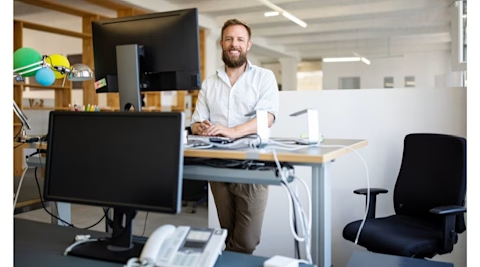Desk ergonomics: Quick fixes for a pain-free day
Tick off this ergonomic checklist with expert Jordan Lees

The average office worker can spend anywhere from four to nine hours a day sitting down, opens in a new tab, making a healthy desk set-up vital for long-term health and wellbeing.
With so many of us splitting our time between a home and work office it’s essential that our desk set-up at both locations is the best it can be to help prevent aches and pains, says Jordan Lees, the Ergonomic Physio, opens in a new tab.
“When COVID meant so many of us were working from home I assumed it would be a good thing, that people would move more, but in reality, the opposite was true,” says Jordan, who specialises in workplace injury prevention and management.
People walk from their bedroom to their desk and stay there. Any prolonged position – sitting or standing – is going to put stress on our bodies and result in symptoms.
Tick off this ergonomic check list for a better desk set up.
Form and function over flair
When you’re buying equipment for a desk space, ergonomics and aesthetics simply don’t mix says Jordan. “One of the biggest issues for people who experience symptoms is not having equipment that's fully adjustable or doesn’t fit your body. Like buying clothes off the rack, chairs don't fit everyone the same and what looks great might not feel right.” Points to remember? Expensive doesn’t mean better. “A lot of $2,000 chairs are much too big for the average person and have levers even I don’t know how to work. Choose a chair that fits your body.” Adjustability is essential. “It’s important to have the ability to change the seat pan and the back rest positions independently. If they adjust simultaneously, it’s difficult to get the right position for you.”
Mouse and keyboard
If your keyboard or mouse are too far away you will need to lean forwards, stressing the shoulder and back muscles. “Keyboard and mouse placement will depend on arm length, but ideally the mouse will be in line with the keyboard to reduce stretch. For the keyboard I typically suggest the people to have it around about 15cm from the edge of the desk.”
Desk and chair height
Unless you have an adjustable desk, you will need to change the chair height to be at the optimum level. “Desk and chair height should ensure your elbows don’t sit below the desk, which will force you to lean forwards when you are using your keyboard,” says Jordan. “Ideally your feet are flat on the floor, but if they’re not, use a footrest which can also help push your body into the backrest.”
Screen height
Looking down – like most of us do when we’re on our phones – stretches the neck muscles and can lead to strains and symptoms. “I put people's eyeline about a third below the top of the screen to stop people leaning forwards. If the chair is set up so that you’re leaning back slightly, your line of vision increases in height. The only caveat would be if someone has multifocal glasses, and they need to look through the middle to the bottom part of the lens.”
Have a primary screen
For those working with multiple screens, reduce the amount of prolonged neck rotations by having a primary screen that sits directly in front of you. “This is most important where people are using a laptop that usually sits much lower than their primary screen, meaning not only are you rotating the neck to look at the laptop, but you’re also flexing down. Putting the laptop on the desk in front of you – so you have keyboard, then laptop, then primary screen – can help reduce this combination of movement.”
Standing desks are great – but not all the time
Standing for prolonged periods is no better than sitting and can actually be harder on the body, says Jordan. “Most people have a threshold as to how long they can sit before their body starts to tell them something doesn’t feel great, and they need to move. It’s the same with standing. The key is not to stand all day – the key is to avoid one position for too long.”
Invest in a headset
If a large portion of your day involves being on the phone, a headset will stop the temptation to contract your neck to hold the phone in place while you type. “That kind of maximum neck contraction is almost guaranteed to lead to symptoms,” says Jordan.
Listen to your body
Muscular aches and pains due to poor ergonomics increase incrementally over time, meaning if you are aware of how your body is feeling, you could prevent pain and injury. “Most people sit on their commute to work, sit at a desk, sit in a café for lunch – it’s unrealistic to say move all day because it will impact productivity. The best thing I can tell people is to listen to their body. If when they sit down at the start of the day feeling great, but two hours later something is niggling or doesn’t feel right, it’s time to move. Even better, move before the symptoms start.”
Contact Jordan at The Ergonomic Physio for assessments, training and more., opens in a new tab

How to treat the flu quickly

Everything you need to know about the 2025 flu vaccine

How improving your gut health can help support your immune system
70 per cent of our immune function is centred in the gut

In partnership with
Jordan Lees
Jordan Lees is a workplace physiotherapist with over 10-years experience assisting clients to implement practical workplace injury prevention and management solutions. He specialises in workplace ergonomics, manual handing training and injury management systems. Outside of work, Jordan is an outdoors man and absolute golf tragic! You can read more about Jordan here.